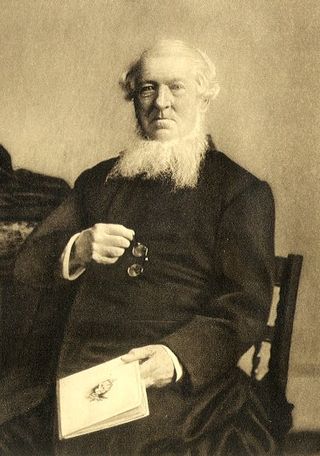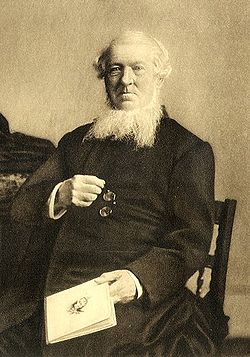Top Qs
Timeline
Chat
Perspective
George Rawlinson
British historian and clergyman (1812–1902) From Wikipedia, the free encyclopedia
Remove ads
George Rawlinson (23 November 1812 – 6 October 1902) was a British scholar, historian and Christian theologian.
Remove ads
Life
Summarize
Perspective
Rawlinson was born at Chadlington, Oxfordshire,[1] the son of Abram Tysack Rawlinson and the younger brother of the famous Assyriologist, Sir Henry Rawlinson. His father was a breeder of racehorses, and bred the winner of the 1841 Derby.[2] Rawlinson was educated at Ealing School. Having taken a First in Literae Humaniores at the University of Oxford (from Trinity College) in 1838,[3] he was elected to a fellowship at Exeter College, in 1840, where he was a Fellow and tutor from 1842 to 1846. He was ordained in 1841, was curate at Merton, Oxfordshire, from 1846 to 1847, was Bampton Lecturer in 1859, and was Camden Professor of Ancient History from 1861 to 1889.[4]
In his early days at Oxford, Rawlinson played cricket for the University, appearing in five matches between 1836 and 1839 which have since been considered to have been first-class.[5]
He was elected as a member of the American Philosophical Society in 1869.[6]
In 1872, he was appointed canon of Canterbury, and after 1888 he was rector of the rich City of London benefice All Hallows, Lombard Street. In 1873, he was appointed proctor in Convocation for the Chapter of Canterbury.[4]
He married in 1846 Louisa Chermside, daughter of Sir Robert Alexander Chermside. The couple had 13 children.[7] They celebrated their golden wedding anniversary in 1896.
Canon Rawlinson died at his residence in Cathedral precincts, Canterbury, on 6 October 1902.[8]
Remove ads
Family
- George Ernest Rawlinson
- Alice Georgiana Rawlinson
- Merial Eudocia Rawlinson
- Catherine Marguerite Jane Rawlinson
- Mary Louisa Rawlinson
- Eleanor Katherine Rawlinson
- Ethel Elisabeth Amy Rawlinson
- Edward Creswicke Scott Rawlinson
- Louisa Henrietta Rawlinson
- Edith Gertrude Rawlinson
- Lionel Seymour Rawlinson
- Charles Brooke Rawlinson
- Eleanor Katherine Rawlinson
Remove ads
Publications
Summarize
Perspective
His chief publications are his translation of the History of Herodotus (in collaboration with Sir Henry Rawlinson and Sir John Gardner Wilkinson), 1858–60; The Five Great Monarchies of the Ancient Eastern World, 1862–67; The Sixth Great Oriental Monarchy (Parthian), 1873; The Seventh Great Oriental Monarchy (Sassanian), 1875; Manual of Ancient History, 1869; Historical Illustrations of the Old Testament, 1871; The Origin of Nations, 1877; History of Ancient Egypt, 1881;[9] Egypt and Babylon, 1885; History of Phoenicia, 1889; Parthia, 1893; Memoir of Major-General Sir HC Rawlinson, 1898.[4]
His lectures to an audience at Oxford University on the topic of the accuracy of the Bible in 1859 were published in later years as the apologetic work The Historical Evidences of the Truth of the Scripture Records Stated Anew.
He was also a contributor to the Speaker's Commentary, the Pulpit Commentary, Smith's Dictionary of the Bible, and various similar publications. He was the author of the article "Herodotus" in the 9th edition of the Encyclopædia Britannica.[4]
In his 1881 book, a History of Ancient Egypt, George Rawlinson wrote that in form the Egyptian most resembled the modern Arab.[10] They were amongst the darkest of races that the Greeks came into contact with, but considered Herodotus to have made extreme exaggerations. Based on his viewing of monuments, he asserted the real complexion of the ordinary Egyptian man was brown-with a tinge of red, which he observed was not very different from the Copts.[10] In another publication entitled Ancient Egypt released in 1887, Rawlinson would state the Egyptian people were of a "mixed-race", derived by movements of Ethiopians from the south, Libyans from the west, and Semitic peoples coming from the north-east of the continent.[11]
References
Sources
External links
Wikiwand - on
Seamless Wikipedia browsing. On steroids.
Remove ads

